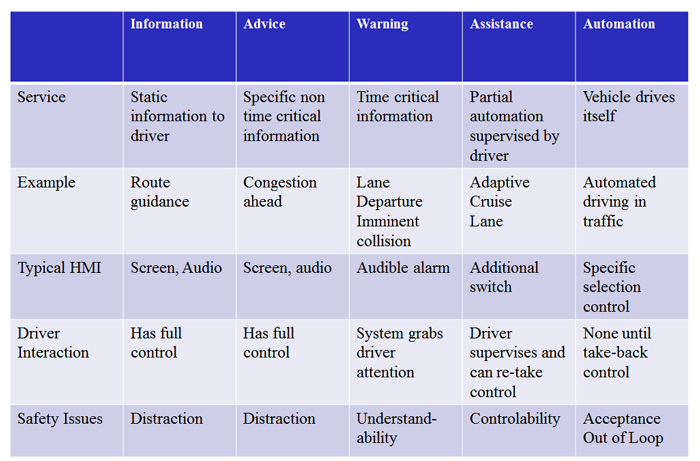
Road Network Operations
& Intelligent Transport Systems
A guide for practitioners!

Road Network Operations
& Intelligent Transport Systems
A guide for practitioners!
ITS can support users with information and warnings, and can provide various levels of assistance and automation depending on the service.
The human factors issues associated with these different “levels” of interaction are very different and these may have safety implications. Appreciating the key differences and understanding these issues can help the Road Operator to purchase, design and implement appropriate ITS.
The manner in which ITS services are implemented impacts on their ease of use. This greatly affects user acceptance and the degree of behaviour adaptation, as well as overall safety.
One characteristic of ITS is the level of support provided to the user. Using a five-fold classification, example ITS services are shown here:
There are different levels of automation for road vehicles:
The human factors and safety issues are different for each different level of interaction or level of automation. The design of the HMI must be different for the different levels – in order to best support the user and promote safety in the transport environment.
The figure below provides a summary of the levels of support and HMI implications in the context of vehicles and driving. For further information see Driver Support

It is important to identify the level of support that ITS is providing to users. Task and error analysis may be useful. (See Human Tasks and Errors)
Secondly, it should be appreciated that the human factors and safety issues are different for each different level of support – so the design of the human machine interaction (HMI) must be different for the different levels, to best support the user and promote safety in the transport environment. (See Road Safety)
Road users can access information in a variety of forms and via different sources. Particular safety issues arise when users, such as drivers and road workers are also involved in safety-critical tasks such as driving or operating machinery. Here, distraction can be a problem so information has to be designed and delivered so that it can be easily used – in the specific context of use. Human factors guidelines are available to assist. Road Operators may wish to restrict access to distracting sources of information to improve safety or design procedures so that information can be accessed safely.
Advice is more specific information that implies or suggests a particular course of action, such as suggesting an alternate route in times of congestion. Understanding and comprehension of the advice is a key issue. The information supplier should provide advice in a clear way which is likely to be easily understood by the intended users. The user response should not be assumed – but should be observed.
Warnings are specific pieces of advice that may require action to be taken in a time-critical way (within a few seconds). Road users have a short period of time in which to understand the warning and take appropriate action. Suppliers of warnings – such as the operations staff at a Traffic Control Centre – should carefully design and test them (to ensure they are well understood and create the intended response) and should consider practice and training so that users become familiar with how to respond. The user response should not be assumed – but should be observed.
Assistance systems automate part of a road user’s task under their own supervision. Driving assistance systems which partly automate the driving task are becoming more common. Specialist machinery used in road construction and maintenance is also becoming more automated. The line between assistance and automation is not completely clear.
Whilst assistance and automation can provide operational and safety benefits, there are several potential safety issues that need to be considered. A key issue is that users over-trust the assistance/automated system and may not appreciate its operational limits. Training and experience should assist here. A related potential problem is poor supervision of the ITS service delivery. (See Automation and Human Factors) It may also be that users become de-skilled as a result of reliance on the assistance – and so are not well prepared to take back control if necessary. Training and practice are good ways to mitigate problems.